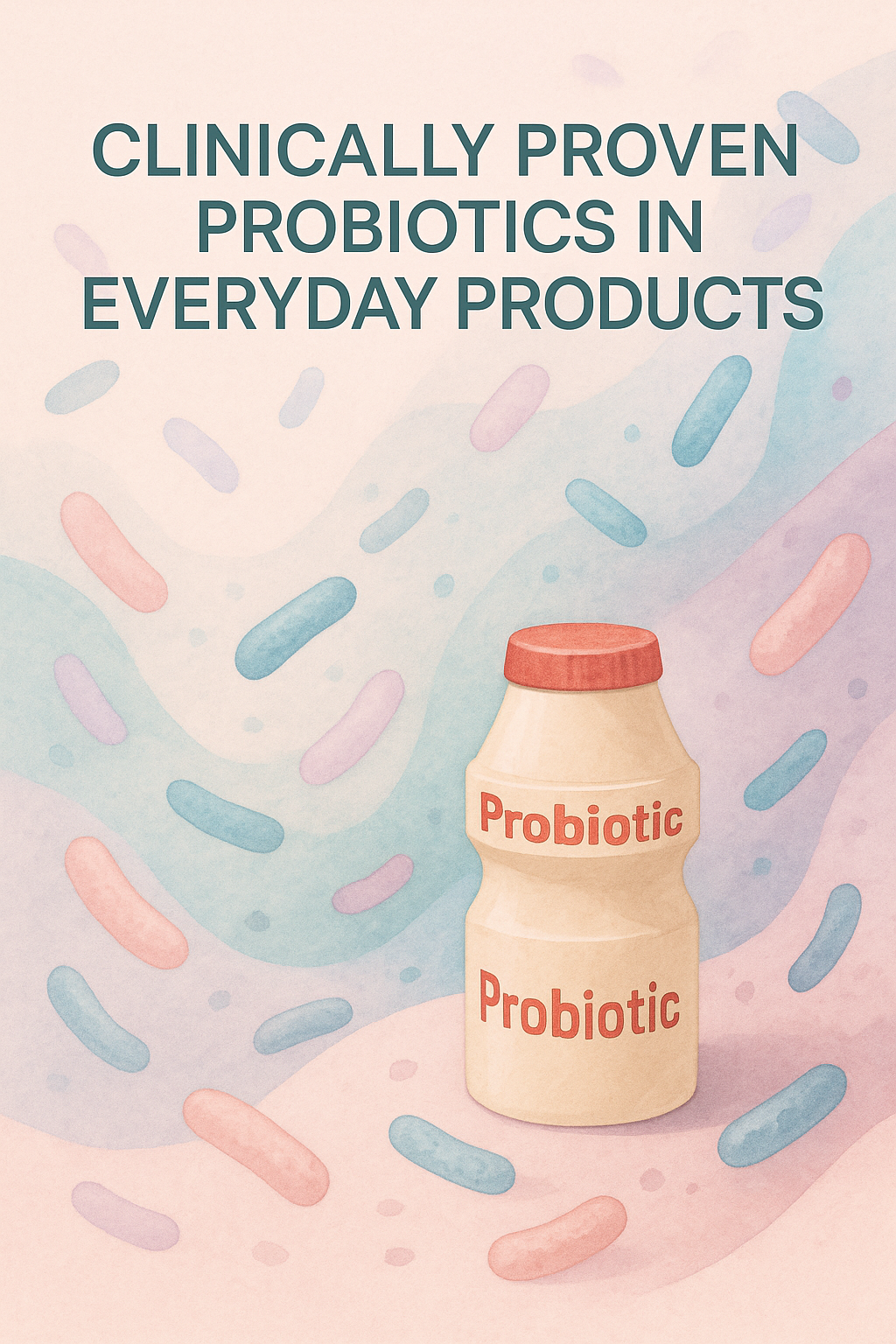
In a world saturated with wellness claims, probiotic products like Yakult, Vitagen, and Activia stand out. They are notable not just for their marketing — but for the strains they contain. This article breaks down the most clinically validated probiotic strains in major consumer products. Each strain is linked to specific health benefits supported by peer-reviewed science.
How Probiotics Work in the Gut
Probiotics are beneficial bacteria in your intestines. They maintain balance in the gut microbiome. This balance influences digestion, immunity, and overall health.
1. They Crowd Out Harmful Microbes
Probiotics compete with pathogens for nutrients and adhesion sites, preventing harmful microbes from colonizing the gut and forming biofilms. [1][2][3]
2. They Strengthen the Gut Barrier
Probiotics (e.g., Lactobacilli, Bifidobacteria) increase tight junction proteins (ZO-1, claudin, occludin), reducing intestinal permeability (“leaky gut”). [4]
3. They Interact with the Immune System
They modulate inflammation and promote mucosal immunity through interaction with gut-associated lymphoid tissue (GALT). [5]
4. They Produce Helpful Metabolites
By fermenting fiber, probiotics generate short-chain fatty acids (SCFAs) — like butyrate — which support gut health and reduce inflammation. [6][7]
5. They Help Restore the Microbiome Post-Disruption
Probiotics help restore microbiota diversity after antibiotics or gut stress. [8]
Clinically Validated Strains in Products
1. Lacticaseibacillus casei Shirota (Yakult)
CFU/Serving: 6.5–20 billion (Australia: 6.5B [9], UK: 20B [10])
In Product: 65 mL Yakult bottle
Benefits
- Decreases upper respiratory infections in athletes [11]
- Increases mucosal immunity [12]
- Reduces antibiotic-associated diarrhea [13]
2. Lactobacillus rhamnosus GG (LGG)
CFU/Serving: 10–20 billion (Culturelle Daily: 10B [14], Ultimate Strength: 20B [15])
In Products: Culturelle, USANA
Benefits:
- Reduces antibiotic-associated diarrhea [16]
- Lowers infant eczema risk [17]
- Immunomodulatory effects [18]
3. Bifidobacterium animalis subsp. lactis BB-12
CFU/Serving: 1–10 billion (Chr. Hansen BB-12 page [19])
In Products: Enfamil, Culturelle Baby, some Activia SKUs
Benefits:
- Alleviates infant colic and constipation [20][21]
- Promotes gut flora diversity [22]
4. Bifidobacterium animalis subsp. lactis DN-173 010 (Bifidus Regularis)
CFU/Serving: ~10 billion (Activia FAQ [23])
In Product: Danone Activia
Benefits:
- Improves GI transit time and bowel regularity [24]
- EFSA-approved digestive claim [25]
5. Lactobacillus reuteri DSM 17938
CFU/Serving: 100–200 million (BioGaia website [26])
In Products: BioGaia ProTectis drops/tablets
Benefits:
- Reduces infant colic [27]
- Aids H. pylori therapy [28]
- Promotes oral health [29]
Regional Variability in CFU Counts
CFU values vary by country and brand formulation. For example:
- Yakult: 6.5B in AU [9], 20B in UK [10]
- Culturelle LGG: 10–20B [14][15]
- BioGaia ProTectis: 100–200M [26]
Check labels for exact values.
Summary
Probiotic effects are strain-specific, and not all products are equally validated. Clinical data confirms that these strains — when dosed appropriately — can meaningfully impact gut health, immunity, and bowel function.
Stay Informed
For more science you can trust, join our mailing list for upcoming explainers and free downloads.
References
- Anderson RC et al. J Nutr. 2010;140(3):587–91.
- Bron PA et al. Front Microbiol. 2017;8:946.
- Woo TD et al. Lett Appl Microbiol. 2013;56(4):307–13.
- Anderson RC et al. J Nutr. 2010;140(3):587–91.
- Bron PA et al. Front Microbiol. 2017;8:946.
- Koh A et al. Cell. 2016;165(6):1332–45.
- Markowiak P, Śliżewska K. Nutrients. 2017;9(9):1021.
- Ouwehand AC. Microorganisms. 2017;5(4):84.
- Yakult Australia official FAQ.
- Yakult UK product page.
- Gleeson M et al. Eur J Appl Physiol. 2011;111(8):1877–85.
- Takeda K et al. J Nutr. 2006;136(10):2617–21.
- Sugawara K et al. Biosci Microbiota Food Health. 2015;34(4):107–12.
- Culturelle Digestive Daily.
- Culturelle Ultimate Strength, iHerb.
- Szajewska H et al. Aliment Pharmacol Ther. 2001;14(5):617–22.
- Dermyshi E et al. Microorganisms. 2017;5(3):40.
- Capurso L. Nutrients. 2019;11(3):701.
- Chr. Hansen BB-12 technical sheet.
- Eskesen D et al. World J Gastroenterol. 2015;21(21):6842–50.
- Savino F et al. Pediatrics. 2010;126(3):e526–33.
- Hughes DT, Hill C. J Appl Microbiol. 2018;124(6):1424–32.
- Activia Australia FAQ.
- Guyonnet D et al. Br J Nutr. 2007;97(4):876–85.
- EFSA Journal. 2008; Probiotic health claims.
- BioGaia ProTectis product page.
- Savino F et al. Pediatrics. 2007;119(1):e124–30.
- Michel M et al. World J Gastroenterol. 2015;21(13):4021–29.
- Vouloumanou EK et al. Int J Antimicrob Agents. 2009;33(6):477.e1–7.
Disclaimer
This article is for educational purposes only and based on the best available literature at the time of writing. Orisynth Bio strives for accuracy but does not guarantee completeness. This is not medical advice. Always consult a qualified healthcare provider. Orisynth Bio accepts no liability for outcomes resulting from the use of this content.
